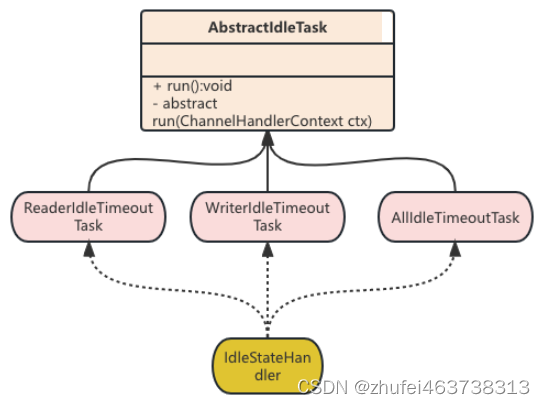24、Netty入门 - Netty心跳机制源码剖析
1.源码剖析的目的
Netty作为一个网络框架,提供了诸多功能,比如编码解码等,Netty 还提供了非常重要的一个服务 ---- 心跳机制 heartbeat。通过心跳检查对方是否有效,这在 RPC 框架中是必不可少的功能。下面我们分析一下 Netty 内部 心跳服务源码的实现。
2.源码解析使用案例
2.1 源码案例
public class MyServer {
public static void main(String[] args) throws InterruptedException {
// 创建两个线程组
NioEventLoopGroup bossGroup = new NioEventLoopGroup(1);
NioEventLoopGroup workerGroup = new NioEventLoopGroup(8);
try {
ServerBootstrap serverBootstrap = new ServerBootstrap();
serverBootstrap.group(bossGroup, workerGroup)
.channel(NioServerSocketChannel.class)
.handler(new LoggingHandler(LogLevel.INFO)) // 在bossgroup增加一个日志处理器
.childHandler(new ChannelInitializer<SocketChannel>() {
@Override
protected void initChannel(SocketChannel ch) throws Exception {
ChannelPipeline pipeline = ch.pipeline();
// 加入 netty 提供的 IdleStateHandler
/**
* 说明
* 1. IdleStateHandler 是 netty 提供的处理空闲状态的处理器
* 2. readerIdleTime:表示多长时间没有读,就会发送一个心跳检测包,检测是否还是连接状态
* 3. writerIdleTime:表示多长时间没有写,就会发送一个心跳检测包,检测是否还是连接状态
* 4. allIdleTime:表示多长时间没有读写,就会发送一个心跳检测包,检测是否还是连接状态
* 5. 当 IdleStateEvent 触发后,就会传递给管道的下一个handler进行处理,通过调用(触发)下一个 handler 的userEventTrigged 方法,
* 在该方法中去处理 IdleStateEvent 事件
*/
pipeline.addLast(new IdleStateHandler(3,5,7, TimeUnit.SECONDS));
// 加入一个对空闲检测进一步处理的handler(自定义)
pipeline.addLast(new MyServerHandler());
}
});
ChannelFuture channelFuture = serverBootstrap.bind(7000).sync();
channelFuture.channel().closeFuture().sync();
}finally {
bossGroup.shutdownGracefully();
workerGroup.shutdownGracefully();
}
}
}
/**
* 心跳处理器
*/
public class MyServerHandler extends ChannelInboundHandlerAdapter {
/**
*
* @param ctx 上下文
* @param evt 事件
* @throws Exception 异常
*/
@Override
public void userEventTriggered(ChannelHandlerContext ctx, Object evt) throws Exception {
if(evt instanceof IdleStateEvent){
// 将 evt 向下转型
IdleStateEvent event = (IdleStateEvent) evt;
String eventType = null;
switch (event.state()){
case READER_IDLE:
eventType = "读空闲";
break;
case WRITER_IDLE:
eventType = "写空闲";
break;
case ALL_IDLE:
eventType = "读写空闲";
break;
}
System.out.println(ctx.channel().remoteAddress() + "--超时事件发生-->" + eventType);
System.out.println("服务器做相应处理......");
}
}
}
如上源码中,我们对 Netty 服务器的(读/写)活动情况进行监听,利用 IdleStateHandler 来完成,其中三个参数分别读、写、读/写 空闲时间。
2.2介绍
Netty 提供了 IdleStateHandler ,ReadTimeoutHandler,WriteTimeoutHandler 三个 Handler 检测连接的有效性。
ReadTimeout 事件和 WriteTimeout 事件都会自动关闭连接,而且,属于异常处理,所以,重点分析IdleStateHandler。
序号 |
名称 |
作用 |
1 |
IdleStateHandler |
当连接的空闲时间(读或者写)太长时,将会触发一个 IdleStateEvent 事件。然后你可以通过你的 ChannelInboundHandler 中重写 userEventTrigged 方法来处理该事件。 |
2 |
ReadTimeoutHandler |
如果在指定的时间没有发生读事件,就会抛出这个异常,并自动关闭这个连接。你可以在 exceptionCaught 方法中处理这个异常。 |
3 |
WriteTimeoutHandler |
当一个写操作不能在一定的时间内完成时,抛出此异常,并关闭连接。你同样可以在 exceptionCaught 方法中处理这个异常。 |
ReadTimeout 事件和 WriteTimeout 事件都会自动关闭连接,而且,属于异常处理,所以,这里只重点介绍IdleStateHandler。
3.IdleStateHandler分析
首先,当调用 addLast 添加 IdleStateHandler 到 pipeline 中时,会触发 handlerAdd 方法
// 添加操作
pipeline.addLast(new IdleStateHandler(3,5,7, TimeUnit.SECONDS));
// 该方法
@Override
public void handlerAdded(ChannelHandlerContext ctx) throws Exception {
if (ctx.channel().isActive() && ctx.channel().isRegistered()) {
// channelActive() event has been fired already, which means this.channelActive() will
// not be invoked. We have to initialize here instead.
initialize(ctx);
} else {
// channelActive() event has not been fired yet. this.channelActive() will be invoked
// and initialization will occur there.
}
}
关注initialize 方法,如下代码中,对 IdleStateHandler 的属性进行初始化过程,涉及到以下几个。
private void initialize(ChannelHandlerContext ctx) {
// Avoid the case where destroy() is called before scheduling timeouts.
// See: https://github.com/netty/netty/issues/143
switch (state) {
case 1:
case 2:
return;
}
state = 1;
initOutputChanged(ctx);
lastReadTime = lastWriteTime = ticksInNanos();
if (readerIdleTimeNanos > 0) {
readerIdleTimeout = schedule(ctx, new ReaderIdleTimeoutTask(ctx),
readerIdleTimeNanos, TimeUnit.NANOSECONDS);
}
if (writerIdleTimeNanos > 0) {
writerIdleTimeout = schedule(ctx, new WriterIdleTimeoutTask(ctx),
writerIdleTimeNanos, TimeUnit.NANOSECONDS);
}
if (allIdleTimeNanos > 0) {
allIdleTimeout = schedule(ctx, new AllIdleTimeoutTask(ctx),
allIdleTimeNanos, TimeUnit.NANOSECONDS);
}
}
-
private final boolean observeOutput; : 是否考虑出站时候较慢的情况,默认是false
-
private final long readerIdleTimeNanos; : 读事件空闲时间,0 则禁用事件
-
private final long writerIdleTimeNanos; : 写事件空闲时间,0 则禁用事件
-
private final long allIdleTimeNanos; : 读/写事件空闲时间,0 则禁用事件
源码中,当参数 > 0 时,就创建一个定时任务,每个事件都创建,同时将 state 设置为1,避免重复初始化,调用 initOutputChanged 方法初始化监控出站数据属性。
创建定时任务源码如下,利用 channel 中的 EventLoop 来添加一个 Scheduler,看源码并 debug,观察 EventLoop 中 Scheduler 线程池中是否有新增任务,如下:
ScheduledFuture<?> schedule(ChannelHandlerContext ctx, Runnable task, long delay, TimeUnit unit) {
return ctx.executor().schedule(task, delay, unit);
}
在ScheduledTaskQueue 中的确有3个Task,因为 addLast 的方法中有三个参数都被初始化了,那么我们来看下对应的三个 Task 实现方法。
三个Task 都是 ChannelDuplexHandler 中的内部类,并且有一个共同父类, AbstractIdleTask
private abstract static class AbstractIdleTask implements Runnable {
private final ChannelHandlerContext ctx;
AbstractIdleTask(ChannelHandlerContext ctx) {
this.ctx = ctx;
}
@Override
public void run() {
if (!ctx.channel().isOpen()) {
return;
}
run(ctx);
}
protected abstract void run(ChannelHandlerContext ctx);
}
- AbstractIdleTask内部类设计用来单例模式,模板模式UML如下

- 模板方法的通用流程:当通道关闭,就不执行任务,反之则执行抽象方法 run 方法,
3.1 读事件 task 分析
- 先看 ReaderIdelTimeoutTask 方法中的 run 方法的实现
private final class ReaderIdleTimeoutTask extends AbstractIdleTask {
ReaderIdleTimeoutTask(ChannelHandlerContext ctx) {
super(ctx);
}
@Override
protected void run(ChannelHandlerContext ctx) {
long nextDelay = readerIdleTimeNanos;
if (!reading) {
nextDelay -= ticksInNanos() - lastReadTime;
}
if (nextDelay <= 0) {
// Reader is idle - set a new timeout and notify the callback.
// 用于取消任务 promise
readerIdleTimeout = schedule(ctx, this, readerIdleTimeNanos, TimeUnit.NANOSECONDS);
boolean first = firstReaderIdleEvent;
firstReaderIdleEvent = false;
try {
// 再次提交任务
IdleStateEvent event = newIdleStateEvent(IdleState.READER_IDLE, first);
// 触发用户 handler use
channelIdle(ctx, event);
} catch (Throwable t) {
ctx.fireExceptionCaught(t);
}
} else {
// Read occurred before the timeout - set a new timeout with shorter delay.
readerIdleTimeout = schedule(ctx, this, nextDelay, TimeUnit.NANOSECONDS);
}
}
}
说明:
1、得到用户设置的超时时间。
2、如果读取操作结束了(执行了 channelReadComplete 方法设置),就用当前时间减去给定时间和最后一次读(执行了操作的时间 channelReadComplete 方法设置),如果小于 0 ,就触发事件。反之,继续放入队列。间隔时间是新的计算时间。
3、触发的逻辑是:首先将任务再次放到队列,时间是刚开始设置的时间,返回一个 promise 对象,用于做取消操作。然后,设置 first 属性为 false,表示下一次读取不是第一次了。这个属性在 channelRead 方法会被改成 true。
4、创建一个 IdleStateEvent 类型的写事件对象,将此对象传递给用户的 UserEventTriggered 方法。完成触发事件的操作。
5、总的来说,每次读取操作都会记录一个时间,定时任务时间到了,会计算当前时间和最后一次读的时间的间隔,如果间隔超过了设置的时间,就出发 UserEventTriggered 方法。
3.2 写事件 task 分析
- 写事件的run方法WriterIdleTimeoutTask, 和读事件的差不多,如下有一点区别
private final class WriterIdleTimeoutTask extends AbstractIdleTask {
WriterIdleTimeoutTask(ChannelHandlerContext ctx) {
super(ctx);
}
@Override
protected void run(ChannelHandlerContext ctx) {
long lastWriteTime = IdleStateHandler.this.lastWriteTime;
long nextDelay = writerIdleTimeNanos - (ticksInNanos() - lastWriteTime);
if (nextDelay <= 0) {
// Writer is idle - set a new timeout and notify the callback.
writerIdleTimeout = schedule(ctx, this, writerIdleTimeNanos, TimeUnit.NANOSECONDS);
boolean first = firstWriterIdleEvent;
firstWriterIdleEvent = false;
try {
if (hasOutputChanged(ctx, first)) {
return;
}
IdleStateEvent event = newIdleStateEvent(IdleState.WRITER_IDLE, first);
channelIdle(ctx, event);
} catch (Throwable t) {
ctx.fireExceptionCaught(t);
}
} else {
// Write occurred before the timeout - set a new timeout with shorter delay.
writerIdleTimeout = schedule(ctx, this, nextDelay, TimeUnit.NANOSECONDS);
}
}
}
- 不通地方在于,run代码中多了一个判断hasOutputChanged 用来判断出站事件处理是否很慢,例如,我一个出站需要写的数据量大,需要处理20秒,但是我们执行写事件监测的时间是 5秒,此时我们只有第一次会触发,因为 hasOutputChanged 中有判断first 的时候还是会执行异常抛出
3.3 所有事件(读/写)事件 task 分析
private final class AllIdleTimeoutTask extends AbstractIdleTask {
AllIdleTimeoutTask(ChannelHandlerContext ctx) {
super(ctx);
}
@Override
protected void run(ChannelHandlerContext ctx) {
long nextDelay = allIdleTimeNanos;
if (!reading) {
nextDelay -= ticksInNanos() - Math.max(lastReadTime, lastWriteTime);
}
if (nextDelay <= 0) {
// Both reader and writer are idle - set a new timeout and
// notify the callback.
allIdleTimeout = schedule(ctx, this, allIdleTimeNanos, TimeUnit.NANOSECONDS);
boolean first = firstAllIdleEvent;
firstAllIdleEvent = false;
try {
if (hasOutputChanged(ctx, first)) {
return;
}
IdleStateEvent event = newIdleStateEvent(IdleState.ALL_IDLE, first);
channelIdle(ctx, event);
} catch (Throwable t) {
ctx.fireExceptionCaught(t);
}
} else {
// Either read or write occurred before the timeout - set a new
// timeout with shorter delay.
allIdleTimeout = schedule(ctx, this, nextDelay, TimeUnit.NANOSECONDS);
}
}
}
-
与写事件基本一致,不同地方在于事件判断
-
nextDelay -= tickInNanos() - Math.max(lastReadTime, lastWriteTime);当前时间-最后一次写/读的时间,如果>0说明超过了
-
此处的时间判断是取读,写事件中的最大值,然后像写事件一样,判断是否发生了写很慢的情况
4.Netty心跳机制总结
1、IdleStateHandler 实现心跳检测功能,当服务器和客户端没有任务读写,并且超过设置事件,会触发 handler 的 userEventTriggered 方法,用户可以在这个方法中实现自己的逻辑。
2、IdleStateHandler 的实现基于 EventLoop 的定时任务,每次读写都会记录一个值,在定时任务运行的时候,通过计算当前时间和设置时间和上次事件发生时间的结果,来判断是否空闲。
3、内部有 3 个定时任务,分别对应读事件、写事件、读写事件。通常用户监听读写事件就足够了。
4、同时,IdleStateHandler 内部也考虑了一些极端情况:客户端接收缓慢,一次接收数据的速度超过了设置的空闲时间。Netty 通过构造方法中的 observeOutput 属性来决定是否对出站缓冲区的情况进行判断。
5、如果出站缓慢,Netty 不任务这是空闲,也就不触发空闲事件。但第一次无论如何也是要触发的。因为第一次无法判断是出站缓慢还是空闲。当然,出站缓慢的话,可能造成 OOM,OOM比空闲的问题更大。
6、所以,当你的应用出现了内存溢出,OOM之类,并且写空闲极少发生(使用了 observeOutput 为 true),那么就需要注意是不是数据出站速度过慢。
7、还有一个注意的地方:就是 ReadTimeoutHandler,它继承自 IdelStateHandler,当触发读空闲事件的时候,就触发 ctx.fireExceptionCaught 方法,并传入一个 ReadTimeoutException,然后关闭 Socket。
8、而 WriteTimeoutHandler 的实现不是基于 IdleStateHandler 的,他的原理是,当调用 write方法的时候,会创建一个定时任务,任务内容是根据传入的 promise 的完成情况来判断是否超出了写的时间。当定时任务根据指定时间开始运行,发现 promise 的 isDone 方法返回 false,表名还没有写完,说明超时了,则抛出异常。当 write 方法完成后,会打断定时任务。